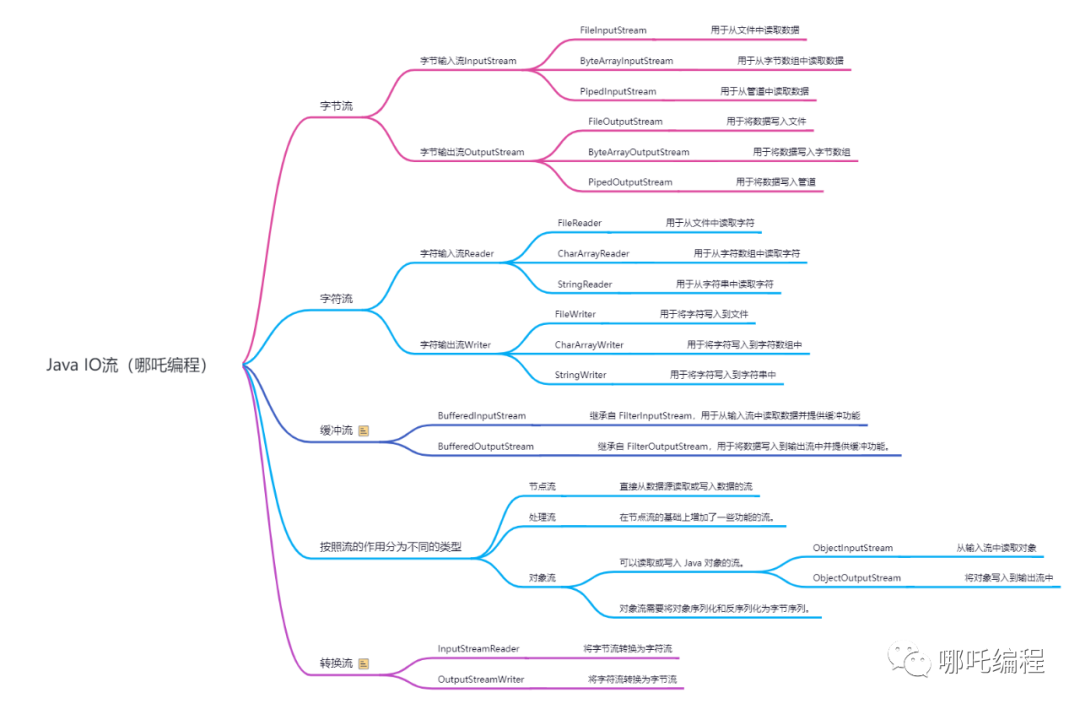
大家好,我是哪吒。
很多朋友问我,如何才能学好IO流,对各种流的概念,云里雾里的,不求甚解。用到的时候,现百度,功能虽然实现了,但是为什么用这个?不知道。更别说效率问题了~
下次再遇到,再百度,“良性循环”。
今天,我就用一天的时间,整理一下关于Java I/O流的知识点,分享给大家。
每一种IO流,都配有示例代码,大家可以跟着敲一遍,找找感觉~

一、InputStream
InputStream 代表一个输入流,它是一个抽象类,不能被实例化。InputStream 定义了一些通用方法,如 read() 和 skip() 等,用于从输入流中读取数据。常用的 InputStream 实现类包括:
1、FileInputStream的代码示例
下面是使用 FileInputStream 读取文件内容的示例代码:
import java.io.*;
public class FileInputStreamExample {
public static void main(String[] args) {
// 要读取的文件路径和名称
String filePath = "C:/example/file.txt";
// 创建输入流对象
FileInputStream fis = null;
try {
fis = new FileInputStream(filePath);
byte[] buffer = new byte[1024];
int len;
// 使用 while 循环读取文件,每次最多读取 1024 个字节
while ((len = fis.read(buffer)) != -1) {
// 将读取的字节转换为字符串,并输出到控制台
String content = new String(buffer, 0, len, "UTF-8");
System.out.println(content);
}
} catch (FileNotFoundException e) {
System.out.println("File not found: " + filePath);
} catch (IOException e) {
System.out.println("Error reading file: " + e.getMessage());
} finally {
// 关闭输入流
try {
if (fis != null) {
fis.close();
}
} catch (IOException e) {
System.out.println("Error closing file: " + e.getMessage());
}
}
}
}示例代码说明:
- 在示例中,我们首先指定要读取的文件路径和名称。在实际使用中,您应该将其替换为实际的文件路径和名称。
- 然后,我们使用文件路径创建一个FileInputStream对象。注意,在创建FileInputStream对象时,我们必须提供要读取的文件的路径和名称。
- 接着,我们使用while循环从FileInputStream对象中读取数据。每次循环中,我们使用read()方法读取最多1024字节,并将读取的字节存储在一个缓冲区中。然后,我们将读取的字节转换为字符串,并在控制台上输出。在while循环结束后,我们关闭FileInputStream对象。
- 注意:在使用FileInputStream类时,我们需要确保文件存在,并且我们有读取文件的权限。此外,在实际应用中,可能需要根据需要使用更高效的方法读取大型文件,以避免IO开销的问题。
2、ByteArrayInputStream的代码示例
下面是使用 ByteArrayInputStream 读取字节数组内容的示例代码:
import java.io.*;
public class ByteArrayInputStreamExample {
public static void main(String[] args) {
byte[] bytes = { 72, 101, 108, 108, 111, 32, 87, 111, 114, 108, 100, 33 };
// 创建字节输入流对象
ByteArrayInputStream bais = new ByteArrayInputStream(bytes);
try {
byte[] buffer = new byte[1024];
int len;
// 使用 while 循环读取字节数组中的内容,每次最多读取 1024 个字节
while ((len = bais.read(buffer)) != -1) {
// 将读取的字节转换为字符串,并输出到控制台
String content = new String(buffer, 0, len, "UTF-8");
System.out.println(content);
}
} catch (IOException e) {
System.out.println("Error reading byte array: " + e.getMessage());
} finally {
// 关闭输入流
try {
if (bais != null) {
bais.close();
}
} catch (IOException e) {
System.out.println("Error closing byte array input stream: " + e.getMessage());
}
}
}
}示例代码说明:
- 在示例中,我们首先创建了一个字节数组,其中包含ASCII码为72, 101, 108, 108, 111, 32, 87, 111, 114, 108, 100, 33的字符序列"Hello World!"。
- 然后,我们使用字节数组创建了一个ByteArrayInputStream对象。注意,在创建ByteArrayInputStream对象时,我们必须提供要从中读取的字节数组。
- 接着,我们使用while循环从ByteArrayInputStream对象中读取数据。每次循环中,我们使用read()方法读取最多1024字节,并将读取的字节存储在一个缓冲区中。然后,我们将读取的字节转换为字符串,并在控制台上输出。在while循环结束后,我们关闭ByteArrayInputStream对象。
- 注意:在使用ByteArrayInputStream类时,字节数组是一次性全部加载到内存中的,如果字节数组较大,可能会导致内存不足的问题。此外,在实际应用中,可能需要使用更高效的数据源(如文件或网络流)来存储数据,以避免内存限制的问题。
3、PipedInputStream的代码示例
PipedInputStream:管道输入流,用于线程之间的通信。
import java.io.IOException;
import java.io.PipedInputStream;
import java.io.PipedOutputStream;
public class PipedInputStreamExample {
public static void main(String[] args) throws Exception {
// 创建一对PipedInputStream和PipedOutputStream
PipedInputStream input = new PipedInputStream();
PipedOutputStream output = new PipedOutputStream(input);
// 创建一个写线程
Thread writerThread = new Thread(new Runnable() {
@Override
public void run() {
try {
// 写入一些数据到PipedOutputStream
output.write("Hello, World!".getBytes());
output.close(); // 关闭PipedOutputStream
} catch (IOException e) {
e.printStackTrace();
}
}
});
// 创建一个读线程
Thread readerThread = new Thread(new Runnable() {
@Override
public void run() {
try {
// 读取PipedInputStream中的数据
int data;
while ((data = input.read()) != -1) {
System.out.print((char) data); // 将数据打印到控制台
}
input.close(); // 关闭PipedInputStream
} catch (IOException e) {
e.printStackTrace();
}
}
});
// 启动写线程和读线程
writerThread.start();
readerThread.start();
// 等待写线程和读线程完成
writerThread.join();
readerThread.join();
}
}代码说明
PipedInputStream和PipedOutputStream是Java IO库提供的一对管道流,可以用于数据的发送和接收。
- 在示例中,我们首先创建了一个PipedInputStream和一个PipedOutputStream。它们被连接在一起,使得我们可以像使用一个普通的输入流- 和输出流一样进行读写操作。
- 接着,我们创建一个写线程来向管道中写入数据。在这个例子中,我们写入了字符串"Hello, World!"。
- 然后,我们创建一个读线程来从管道中读取数据。我们使用了一个while循环来读取数据,直到遇到了流的末尾。
- 最后,我们启动写线程和读线程,等待它们完成,然后关闭流。
- 注意:如果读线程在数据被写入管道之前就开始读取流,它将会阻塞(即等待数据被写入)。
- 另外,还要注意线程之间的同步问题。在这个例子中,我们使用了一个简单的join()方法来等待写线程和读线程完成。在实际使用中,您可能需要使用更高级的同步机制来确保线程之间的正确协作。
二、 OutputStream
OutputStream 代表一个输出流,它也是一个抽象类,不能被实例化。OutputStream 定义了一些通用方法,如 write() 和 flush() 等,用于向输出流中写入数据。常用的 OutputStream 实现类包括:
1、FileOutputStream代码示例
文件输出流,用于向文件中写入数据。
import java.io.*;
public class FileOutputStreamExample {
public static void main(String[] args) {
// 要写入的文件路径和名称
String filePath = "C:/example/output.txt";
// 要写入文件的内容
String content = "Hello, World!";
// 创建输出流对象
FileOutputStream fos = null;
try {
fos = new FileOutputStream(filePath);
// 将字符串转换为字节数组,并将其写入文件
fos.write(content.getBytes("UTF-8"));
// 刷新输出流
fos.flush();
// 输出提示信息
System.out.println("Content has been written to " + filePath);
} catch (FileNotFoundException e) {
System.out.println("File not found: " + filePath);
} catch (IOException e) {
System.out.println("Error writing file: " + e.getMessage());
} finally {
// 关闭输出流
try {
if (fos != null) {
fos.close();
}
} catch (IOException e) {
System.out.println("Error closing file: " + e.getMessage());
}
}
}
}示例代码说明:
- 在示例中,我们首先指定要写入的文件路径和名称。在实际使用中,您应该将其替换为实际的文件路径和名称。
- 然后,我们创建一个用于写入文件的输出流对象。在创建FileOutputStream对象时,如果文件不存在,Java将会自动创建它。
- 接着,我们将要写入的内容转换为字节数组,并使用write()方法将其写入文件。
- 然后,我们使用flush()方法刷新输出流。在文件操作完成后,我们应该始终调用flush()方法以确保所有数据都被写入到磁盘上的文件中。
- 最后,我们关闭FileOutputStream对象,即使在发生异常时也应该关闭。
- 注意:在使用FileOutputStream类时,我们需要确保文件存在,并且我们有写入文件的权限。此外,在实际应用中,可能需要使用更高效的方法来写入大型文件,以避免IO开销的问题。
2、ByteArrayOutputStream代码示例:
字节数组输出流,用于将数据写入内存中的字节数组中。
import java.io.*;
public class ByteArrayOutputStreamExample {
public static void main(String[] args) {
// 创建字节数组输出流对象
ByteArrayOutputStream baos = new ByteArrayOutputStream();
try {
// 将字符串转换为字节数组,并写入到字节数组输出流中
baos.write("Hello, World!".getBytes("UTF-8"));
// 将字节数组输出流中的数据转换为字节数组
byte[] bytes = baos.toByteArray();
// 将字节数组转换为字符串,并输出到控制台
String content = new String(bytes, "UTF-8");
System.out.println(content);
} catch (IOException e) {
System.out.println("Error writing to byte array: " + e.getMessage());
} finally {
// 关闭字节数组输出流
try {
if (baos != null) {
baos.close();
}
} catch (IOException e) {
System.out.println("Error closing byte array output stream: " + e.getMessage());
}
}
}
}示例代码说明:
- 在示例中,我们首先创建了一个ByteArrayOutputStream对象,用于向内存中的字节数组中写入数据。
- 然后,我们将要写入的内容转换为字节数组,并使用write()方法将其写入ByteArrayOutputStream对象。
- 接着,我们调用toByteArray()方法将ByteArrayOutputStream对象中的数据转换为字节数组。需要注意的是,要在调用toByteArray()方法之前先关闭ByteArrayOutputStream。
- 最后,我们将字节数组转换为字符串,并将其输出到控制台。
- 注意:在使用ByteArrayOutputStream类时,需要注意内存占用问题。BytesArrayOutputStream类主要用于在内存中临时存储数据。对于大数据,可能需要使用其他方式存储。
3、PipedOutputStream代码示例:
管道输出流,用于线程之间的通信。
import java.io.*;
public class PipedOutputStreamExample {
public static void main(String[] args) {
// 创建一对PipedInputStream和PipedOutputStream
PipedInputStream input = new PipedInputStream();
PipedOutputStream output = new PipedOutputStream();
try {
// 将输入流和输出流连接起来
input.connect(output);
// 创建一个写线程
Thread writerThread = new Thread(new Runnable() {
@Override
public void run() {
try {
// 写入一些数据到PipedOutputStream
output.write("Hello, World!".getBytes("UTF-8"));
// 刷新PipedOutputStream
output.flush();
// 关闭PipedOutputStream
output.close();
} catch (IOException e) {
System.out.println("Error writing to pipe: " + e.getMessage());
}
}
});
// 创建一个读线程
Thread readerThread = new Thread(new Runnable() {
@Override
public void run() {
try {
// 读取PipedInputStream中的数据
byte[] buffer = new byte[1024];
int len = input.read(buffer);
// 将读取的字节转换为字符串,并输出到控制台
String content = new String(buffer, 0, len, "UTF-8");
System.out.println(content);
// 关闭PipedInputStream
input.close();
} catch (IOException e) {
System.out.println("Error reading from pipe: " + e.getMessage());
}
}
});
// 启动写线程和读线程
writerThread.start();
readerThread.start();
// 等待写线程和读线程完成
writerThread.join();
readerThread.join();
} catch (IOException | InterruptedException e) {
System.out.println("Error communicating between threads: " + e.getMessage());
}
}
}示例代码说明:
- 在示例中,我们首先创建了一对PipedInputStream和PipedOutputStream,用于在线程之间进行通信。
- 接着,我们使用connect()方法将PipedInputStream和PipedOutputStream连接起来。
- 然后,我们创建一个写线程和一个读线程。在写线程中,我们向PipedOutputStream写入数据,并使用flush()和close()方法刷新和关闭输出流。在读线程中,我们从PipedInputStream读取数据,并将其转换为字符串并打印到控制台。在读操作完成后,我们关闭输入流
- 最后,我们启动写线程和读线程,并等待它们完成。
- 注意:在使用PipedInputStream和PipedOutputStream类时,需要考虑线程同步问题,以确保在线程之间正确地交换数据。在实际应用中,您可能需要使用更高级的同步机制来确保线程之间的协作。
三、字符输入流Reader
除了字节流,Java 还提供字符流,字符流类似于字节流,不同之处在于字符流是按字符读写数据,而不是按字节。Java 中最基本的字符流是 Reader 和 Writer,它们是基于 InputStream 和 OutputStream 的转换类,用于完成字节流与字符流之间的转换。
常用的实现类包括 FileReader 和 InputStreamReader等
1、FileReader 代码示例
import java.io.FileReader; // 引入 FileReader 类
import java.io.IOException; // 引入 IOException 类
public class FileReaderExample {
public static void main(String[] args) {
// 定义文件路径
String filePath = "example.txt";
try {
// 创建 FileReader 对象
FileReader fileReader = new FileReader(filePath);
// 读取字符
int character;
while ((character = fileReader.read()) != -1) {
// 打印字符
System.out.print((char) character);
}
// 关闭 FileReader 对象
fileReader.close();
} catch (IOException e) {
e.printStackTrace();
}
}
}2、InputStreamReader 代码示例
import java.io.BufferedReader; // 引入 BufferedReader 类
import java.io.IOException; // 引入 IOException 类
import java.io.InputStreamReader; // 引入 InputStreamReader 类
public class InputStreamReaderExample {
public static void main(String[] args) {
try {
// 创建 InputStreamReader 对象
InputStreamReader inputStreamReader = new InputStreamReader(System.in);
// 创建 BufferedReader 对象
BufferedReader bufferedReader = new BufferedReader(inputStreamReader);
// 获取用户输入
System.out.println("请输入字符串:");
String inputString = bufferedReader.readLine();
// 打印用户输入
System.out.println("您输入的字符串是:" + inputString);
// 关闭 BufferedReader 对象
bufferedReader.close();
} catch (IOException e) {
e.printStackTrace();
}
}
}四、字符输出流Writer
1、FileWriter代码示例
import java.io.*;
public class FileWriterExample {
public static void main(String[] args) {
FileWriter writer = null;
try {
writer = new FileWriter("example.txt");
writer.write("Hello World!");
writer.close();
} catch (IOException e) {
System.out.println("Error: " + e.getMessage());
} finally {
try {
if (writer != null)
writer.close();
} catch (IOException e) {
System.out.println("Error: " + e.getMessage());
}
}
}
}示例代码说明:
- 在这个例子中,创建了一个FileWriter对象 writer,并将字符串"Hello World!"写入文件 "example.txt"。然后,我们使用close()方法关闭写入器以确保所有的数据都被刷新到磁盘。
- 注意:在使用FileWriter时,要确保在不再需要它时关闭它以确保所有的字符都被刷新到文件中。如果您使用Java7或更高版本,可以考虑使用try-with-resources语句,这样您就不需要显式地关闭写入器。
2、OutputStreamWriter代码示例
import java.io.*;
public class OutputStreamWriterExample {
public static void main(String[] args) {
FileOutputStream outputStream = null;
OutputStreamWriter writer = null;
try {
outputStream = new FileOutputStream("example.txt");
writer = new OutputStreamWriter(outputStream, "UTF-8");
writer.write("Hello World!");
writer.close();
} catch (IOException e) {
System.out.println("Error: " + e.getMessage());
} finally {
try {
if (writer != null)
writer.close();
if (outputStream != null)
outputStream.close();
} catch (IOException e) {
System.out.println("Error: " + e.getMessage());
}
}
}
}示例代码说明:
- 在这个例子中,创建了一个FileOutputStream对象 outputStream 用于写入文件 "example.txt"。接着,创建了一个OutputStreamWriter对象 writer,它被用于将字符串"Hello World!"写入到文件中。指定了"UTF-8"作为字符编码。
- 最后,使用close()方法关闭写入器和输出流以确保所有的数据都被刷新到磁盘上。
- 注意:在使用OutputStreamWriter时,要确保在不再需要它时关闭它以确保所有的字符都被刷新到文件中。如果您使用Java 7或更高版本,可以考虑使用try-with-resources语句,这样您就不需要显式地关闭写入器和输出流。
五、缓冲流
BufferedInputStream 和 BufferedOutputStream 是 I/O 包中提供的缓冲输入输出流。它们可以提高 I/O 操作的效率,具有较好的缓存机制,能够减少磁盘操作,缩短文件传输时间。使用 BufferedInputStream 和 BufferedOutputStream 进行读取和写入时,Java 会自动调整缓冲区的大小,使其能够适应不同的数据传输速度。
缓冲流代码示例
import java.io.BufferedInputStream; // 引入 BufferedInputStream 类
import java.io.BufferedOutputStream; // 引入 BufferedOutputStream 类
import java.io.FileInputStream; // 引入 FileInputStream 类
import java.io.FileOutputStream; // 引入 FileOutputStream 类
import java.io.IOException; // 引入 IOException 类
public class BufferedStreamsExample {
public static void main(String[] args) {
String sourceFile = "source.txt";
String targetFile = "target.txt";
try {
// 创建 BufferedInputStream 和 BufferedOutputStream 对象
BufferedInputStream bufferedInputStream = new BufferedInputStream(new FileInputStream(sourceFile));
BufferedOutputStream bufferedOutputStream = new BufferedOutputStream(new FileOutputStream(targetFile));
// 读取数据,直到读取的内容为-1
int data;
while ((data = bufferedInputStream.read()) != -1) {
bufferedOutputStream.write(data);
}
// 关闭 BufferedInputStream 和 BufferedOutputStream 对象
bufferedInputStream.close();
bufferedOutputStream.close();
// 打印成功信息
System.out.println("复制文件成功!");
} catch (IOException e) {
e.printStackTrace();
}
}
}六、对象流
可以读取或写入 Java 对象的流,比较典型的对象流包括ObjectInputStream 和 ObjectOutputStream。
对象流需要将对象序列化和反序列化为字节序列,使用 ObjectInputStream 和 ObjectOutputStream 可以将 Java 对象转换为字节流进行传输或存储。
在网络传输和文件存储中,ObjectInputStream 和 ObjectOutputStream 通常会被使用到。
对象流代码示例
import java.io.FileInputStream; // 引入 FileInputStream 类
import java.io.FileOutputStream; // 引入 FileOutputStream 类
import java.io.ObjectInputStream; // 引入 ObjectInputStream 类
import java.io.ObjectOutputStream; // 引入 ObjectOutputStream 类
import java.io.Serializable; // 引入 Serializable 接口
class Person implements Serializable {
String name;
int age;
public Person(String name, int age) {
this.name = name;
this.age = age;
}
public String toString() {
return "姓名:" + name + "\n年龄:" + age;
}
}
public class ObjectStreamsExample {
public static void main(String[] args) {
String filePath = "person.dat";
// 创建 Person 对象
Person person = new Person("Alice", 20);
try {
// 创建 ObjectOutputStream 对象
ObjectOutputStream objectOutputStream = new ObjectOutputStream(new FileOutputStream(filePath));
// 将 Person 对象写入文件
objectOutputStream.writeObject(person);
// 关闭 ObjectOutputStream 对象
objectOutputStream.close();
// 创建 ObjectInputStream 对象
ObjectInputStream objectInputStream = new ObjectInputStream(new FileInputStream(filePath));
// 从文件中读取 Person 对象
Person personFromFile = (Person) objectInputStream.readObject();
// 关闭 ObjectInputStream 对象
objectInputStream.close();
// 打印读取的对象
System.out.println(personFromFile);
} catch (Exception e) {
e.printStackTrace();
}
}
}本文转载自微信公众号「哪吒编程」,可以通过以下二维码关注。转载本文请联系哪吒编程公众号。


































